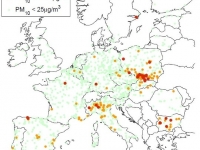Health
Europe is drowning
Air pollution exceeds maximum
USPA NEWS -
The quality of the air they breathe European pollution exceeds the limits set by the EU and the World Health Organization. A study by the International Institute for Applied Systems Analysis, air quality in Europe is low and requires immediate government intervention to reduce air pollution levels.
The study was done on particles suspended in air monitoring stations in all EU countries, both in rural and urban areas. According to the IIASA, measurements were made "exactly where it is important to see if the air quality criteria are met“. The institute said in a statement that current air quality legislation in Europe will lead to significant improvements in particulate matter pollution, but without further emission control efforts, many areas of Europe will continue to see air pollution levels above the limits of the EU and the World Health Organization. Strict control of vehicle emissions alone will not be sufficient to achieve the limit values.
Under current legislation, air pollution hotspots will remain in Eastern Europe, Southern Poland and major European cities such as Warsaw, Paris, and Milan, according to a new study published in the journal Atmospheric Chemistry and Physics by researchers at the IIASA and colleagues around Europe. “This is the first time that we have analyzed particulate matter at individual monitoring stations across Europe, from regional background to urban streets, exactly where it´s important to know if air quality limits will be met", says IIASA researcher Gregor Kiesewetter, who led the study.
"We show the potential and the need for further emission controls to achieve safe levels of air quality. Current legislation will not do the job", he adds. Air pollution has a major impact on human health, contributing to lung and heart disease. Exposure to particulate matter was linked to as many as 400,000 premature deaths in 2011 in Europe, according to the European Environment Agency.
EU legislation sets limit values on ambient concentrations for particulate matter of less than 10 microns in diameter (PM10). While new policies in Europe have contributed to significant decreases in air pollution over the past several decades, an estimated 80% of Europe´s population is still exposed to PM levels above WHO air quality guidelines, and a significant proportion of the region still exceeds the air quality limit values set by EU law. Such pollution comes from a number of sources, including power plants, agriculture, domestic heating, and city traffic. IIASA´s GAINS model has been used for years to provide estimates of emissions and air pollution levels to support policymakers in Europe and around the world.
In particular, the model has been employed in the ongoing revision of the EU air quality legislation. “We are now able to explicitly identify the different sources contributing to ambient pollution levels. Some cities clearly have a local problem that may be tackled by local measures. In many others, like Vienna, the majority of measured concentrations comes from sources outside the city or even outside the country“, explains Kiesewetter, who adds that “approaching the WHO guideline value will require emission reductions from various sources, two of which were often overlooked in the past. Especially in Eastern Europe, emissions from solid fuels used for home heating are dominating".
"In many European regions we also see an important contribution of secondary inorganic aerosols, which are steered by agricultural ammonia emissions", according Kiesewetter. Using the improved model, the researchers explored two scenarios for how air pollution levels could develop across Europe by 2030. Assuming that current legislation is successfully implemented, average air pollution levels would decrease substantially. However, the study shows that a substantial proportion of the European population would still be exposed to PM10 concentrations exceeding EU standards in 2030, in particular in southern Poland, the Czech Republic, Slovakia, northern Italy, and Bulgaria, as well as in a number of major cities.
In a second scenario, the researchers examined what would happen if the most efficient air pollution control technologies that are currently available were implemented across Europe. In this case, they found that by 2030, 99% of monitoring stations would see air pollution levels reduced below EU limits. “A mix of EU-wide and local measures will be needed to bring PM concentrations below limit values. We show that coordinated EU-wide action could eliminate a large part of the problem,“ explains Kiesewetter.
Liability for this article lies with the author, who also holds the copyright. Editorial content from USPA may be quoted on other websites as long as the quote comprises no more than 5% of the entire text, is marked as such and the source is named (via hyperlink).






